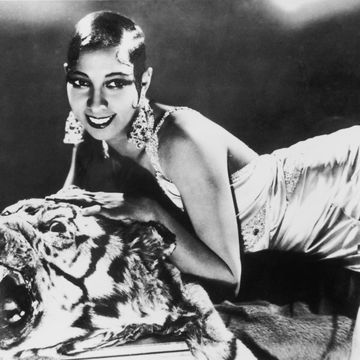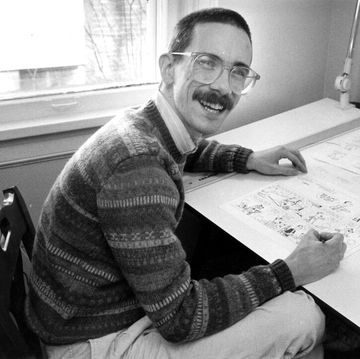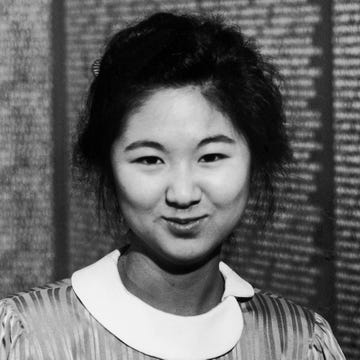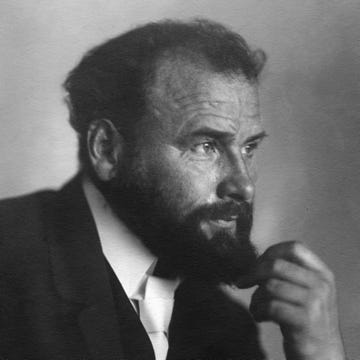(1922-2000)
Who Was Charles Schulz?
Charles Schulz launched his comic strip Peanuts in 1950. Featuring hero Charlie Brown, over the years the strip would run in more than 2,000 newspapers and in many languages. Peanuts also expanded into TV specials like the Emmy-winning A Charlie Brown Christmas, as well as books and a huge merchandise collection. Schulz died on February 12, 2000.
Early Life
Charles Monroe Schulz was born on November 26, 1922, in Minneapolis, Minnesota. The only child of dad Carl, a German immigrant and barber, and mom Dena, a waitress turned homemaker, Schulz spent most of his childhood in the Twin Cities, outside of a two-year stint in Needles, California, after the onset of the Great Depression.
Schulz realized at an early age that he wanted to become a cartoonist. He sat down with his dad to read the Sunday funny papers every week, becoming a fan of E.C. Segar’s Thimble Theatre (which featured Popeye), Percy Crosby’s Skippy and Al Capp’s L’il Abner. The burgeoning cartoonist received a thrill in 1937, when his drawing of the family dog, Spike, was published in Robert Ripley’s popular Believe It or Not! feature. Late in his senior year at St. Paul’s Central High School, Schulz enrolled in a correspondence course at the Federal School of Applied Cartooning in Minneapolis. He worked odd jobs as he began submitting his cartoons to publications, but his career plans were halted when he was drafted into the U.S. Army in the fall of 1942. Shortly after he left for basic training, his mom passed away at age 50 from cervical cancer.
War Service and Early Career
Assigned to Company B in the Eighth Armored Battalion of the Twentieth Armored Infantry Division, Schulz trained as a machine gunner at Kentucky's Fort Campbell, rising to the rank of staff sergeant. His unit was shipped to Europe in February 1945, where they helped lead the charge on Munich and liberate the Dachau concentration camp. After Germany’s surrender, Schulz received the Combat Infantryman Badge for fighting in active ground combat under hostile fire. He was then sent to Camp Cooke in California, before earning his official discharge on January 6, 1946.
Schulz maintained his interest in cartooning during the war, developing an affinity for Bill Mauldin's Willie and Joe characters in the military publication Stars and Stripes, and afterward, he began working as an instructor at his old cartooning school. The job gave him the opportunity to hone his technique, and he finally had one of his pieces published in early 1947. That year also brought the debut of Schulz's weekly panel in the St. Paul Pioneer Press. Titled Li'l Folks, and attributed to the artist's childhood nickname of "Sparky," the cartoon featured prototypes of the soon-to-be iconic characters of Charlie Brown and Snoopy. Additional recognition came in 1948 when Schulz had the first of 17 cartoons published in The Saturday Evening Post. After multiple attempts to get Li'l Folks syndicated, Schulz scored a breakthrough when United Feature Syndicate purchased his strip in 1950. However, due to conflicts with other similarly named comics, he grudgingly agreed to retitle his strip Peanuts.
Peanuts Characters
Peanuts made its official debut in seven newspapers on October 2, 1950. The inaugural four-panel comic, in which a boy remarks how he hates "Good ol' Charlie Brown," set the tone for its bald-headed hero. Before long, fans grew attached to the quirky, philosophical cast of characters; the oft-maligned Charlie Brown, who always strikes out and gets his kite stuck in a tree; bossy Lucy, and her security blanket-toting little brother, Linus; the Beethoven-loving Schroeder, his head always buried in his toy piano; and Snoopy, the pet who sleeps atop his doghouse and engages in imaginative midair battles with the Red Baron.
Schulz funneled his own life experiences into the strip: Snoopy was based on his old family dog, Spike (a name revived later with the introduction of Snoopy's brother). Lucy's cruel tendency to pull a football away from Charlie Brown was inspired by childhood antics. And the Little Red-Haired Girl, the never-seen source of Charlie Brown's romantic anguish, was drawn from an old girlfriend who had spurned Schulz's marriage proposal.
Peanuts earned Schulz the Reuben Award for Outstanding Cartoonist of the Year in 1955 (and again in 1964), and soon developed an appeal that transcended the boundaries of the funny pages. Exhibits of Peanuts originals were displayed at the Rhode Island School of Design and the University of Minnesota, and Schulz was honored by Yale University as its Humorist of the Year. By 1960, Charlie Brown, Snoopy and the crew were being featured in Hallmark greeting cards and advertisements for Ford automobiles.
In the early 1960s, Schulz was approached by a young television producer named Lee Mendelson for the purpose of filming a documentary. Although the documentary never aired, their meeting marked the start of a lifelong collaboration, and they soon teamed up to create the television special A Charlie Brown Christmas (1965). Featuring the animation of Bill Melendez, and a delightful score by jazz musician and composer Vince Guaraldi, the program was honored with both an Emmy and a Peabody Award in 1966. Additional TV specials soon followed, with Charlie Brown's All-Stars and It's the Great Pumpkin, Charlie Brown both airing that year.
Underscoring their standing as pop culture superstars, the Peanuts characters graced the cover of Time and were the subject of a hit song by The Royal Guardsmen. A stage production of You’re A Good Man, Charlie Brown debuted in New York City in 1967, and two years later, the feature-length film A Boy Named Charlie Brown opened at the Radio City Music Hall.
Later Works, Death and Legacy
After the additions of such new faces as Peppermint Patty, Marcie and Franklin – Peanuts’ first African American character – Schulz and his team continued to churn out award-winning TV specials to accompany the strip. Additional feature-length movies included Snoopy Come Home (1972) and Bon Voyage, Charlie Brown (and Don’t Come Back!!) (1980).
Resuming his drawing after undergoing quadruple-bypass surgery in 1981, Schulz continued to handle the daily creation of his strip all by himself, even after developing a hand tremor in later years. However, when abdominal surgery brought a diagnosis of colon cancer in late 1999, the cartoonist announced he was retiring.
On February 12, 2000, the night before his final Peanuts cartoon was published, Schulz died in his sleep. At the time, Peanuts was reaching readers in 21 languages across some 2,600 newspapers in 75 countries. Altogether, Schulz produced more than 18,000 strips over nearly 50 years of work.
The famed cartoonist received several posthumous honors, including the Congressional Gold Medal. In 2002, the Charles M. Schulz Museum and Research Center opened in Santa Rosa, displaying original artwork, letters, photographs and other memorabilia.
With its characters continuing to appear in daily newspapers, anniversary books, TV specials and commercials, the Peanuts empire has shown little signs of diminishing. Marking the 65th anniversary of his beloved strip's debut on October 2, 1950, Schulz was inducted into the California Hall of Fame in late September 2015. The honor came on the eve of a brand-new Peanuts 3D movie, which hit theaters in November 2015.
Personal Life
Schulz married Joyce Halverson in 1951 and adopted her young daughter, Meredith. The family grew as the couple had children of their own: Charles Jr. (Monte), Craig, Amy and Jill all arrived by 1958.
After several years in Colorado Springs, Schulz turned his sights westward by purchasing a 28-acre property in Sonoma County, California. The family set about renovating the grounds, adding such features as a swimming pool, a miniature golf course and horse stables. In 1969, Schulz opened the Redwood Empire Ice Arena in nearby Santa Rosa. Known as "Snoopy's Home Ice," the arena began hosting an annual hockey tournament in 1975.
Schulz and Joyce divorced in 1972, and the following year he married his second wife, Jeannie Clyde.
QUICK FACTS
- Name: Charles Monroe Schulz
- Birth Year: 1922
- Birth date: November 26, 1922
- Birth State: Minnesota
- Birth City: Minneapolis
- Birth Country: United States
- Gender: Male
- Best Known For: Charles Schulz was the creator and cartoonist behind 'Peanuts,' a globally popular comic strip that expanded into TV, books and other merchandise.
- Industries
- Art
- Astrological Sign: Sagittarius
- Nacionalities
- German
- Death Year: 2000
- Death date: February 12, 2000
- Death State: California
- Death City: Santa Rosa
- Death Country: United States
Fact Check
We strive for accuracy and fairness.If you see something that doesn't look right,contact us!
CITATION INFORMATION
- Article Title: Charles Schulz Biography
- Author: Biography.com Editors
- Website Name: The Biography.com website
- Url: https://www.biography.com/artists/charles-schulz
- Access Date:
- Publisher: A&E; Television Networks
- Last Updated: March 29, 2021
- Original Published Date: April 2, 2014
QUOTES
- I love mankind; it's people I can't stand.
- I'm astonished at the number of people who write to me saying, 'Why can't you create happy stories for us? Why does Charlie Brown always have to lose? Why can't you let him kick the football?' Well, there is nothing funny about the person who gets to kick the football.
- All the loves in the strip are unrequited; all the baseball games are lost; all the test scores are D-minuses; the Great Pumpkin never comes; and the football is always pulled away.
The Biography.com staff is a team of people-obsessed and news-hungry editors with decades of collective experience. We have worked as daily newspaper reporters, major national magazine editors, and as editors-in-chief of regional media publications. Among our ranks are book authors and award-winning journalists. Our staff also works with freelance writers, researchers, and other contributors to produce the smart, compelling profiles and articles you see on our site. To meet the team, visit our About Us page: https://www.biography.com/about/a43602329/about-us












